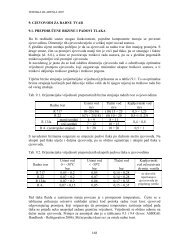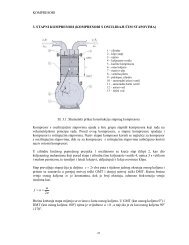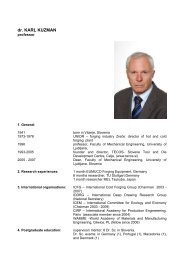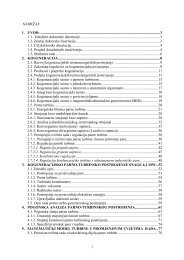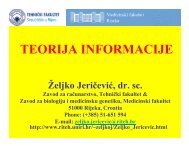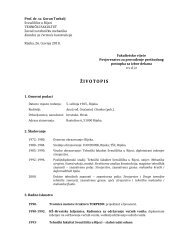universityâenterprise cooperation
universityâenterprise cooperation
universityâenterprise cooperation
Create successful ePaper yourself
Turn your PDF publications into a flip-book with our unique Google optimized e-Paper software.
108<br />
economic activity. For example, spin-offs are<br />
the main mechanism for the rapid growth<br />
of technopolises like Silicon Valey, Route<br />
128, Austin, Cambridge and others. The<br />
university spin-off is defined as a company<br />
that is founded<br />
1. By a faculty member, staff member, or<br />
students who left the university to start<br />
a company or who started the company<br />
while still affiliated with the university;<br />
and/or<br />
2. Around a technology or technology-based<br />
idea developed within the university.<br />
To survive and prosper in an era of global<br />
competition, universities must become<br />
entrepreneurial universities. Entrepreneurial<br />
university means much more than the transfer of<br />
knowledge or the birthplace of high technology<br />
spin-offs. Being an entrepreneurial university<br />
means being innovative with its programmes,<br />
research projects, institutional development,<br />
internationalization, and being able to generate<br />
income to supplement government funding. The<br />
regional benefit need not be produced simply<br />
by interactions between the university and its<br />
spin-off companies. It is important to stress<br />
that the regional knowledge pool remains an<br />
important part of the contribution that spinoffs<br />
bring, through the various elements of<br />
relationships between universities and their<br />
spin-offs However, as it is shown in the model<br />
in Figure 4 there are other actors and other<br />
important relationships contributing to this<br />
positive relationship and to the regional<br />
impact in terms of creating territorial learning<br />
and knowledge assets.<br />
Bering in mind that WBC region has a pool<br />
of talented, motivated and well-educated<br />
young researchers, we suggest forming<br />
incubation centers within Science and<br />
Technology parks with the aim to encourage<br />
academics and students to establish spin-off<br />
companies to commercialize the results<br />
of scientific inventions made within the<br />
academic laboratories. Such companies are<br />
typically small high technology companies.<br />
The commercialization of scientific research<br />
through spin-offs is a direct means of<br />
transferring knowledge from higher education<br />
institutions to the SME sector. The close<br />
proximity to the Universities in WBCs, the<br />
possibilities of networking with both big and<br />
small companies in the local environment,<br />
Case Study: DMS Group<br />
The DMS Group, Novi Sad, located within the science-technology part of the University in Novi Sad, Serbia,<br />
is an advanced IT company of more than 300 developers (the average age of the group is 35) that has created the<br />
Distribution Management System (DMS) software product. DMS Software is organized modularly, the partner<br />
companies are able to selectively use only the parts (software) missing from their offer (e.g. selected DMS<br />
Functions, data base, graphic user interface, DMS server, etc). Apart from selling licenses for DMS Software,<br />
DMS Group has a large and experienced project team, which, on partner companies’ requests, provides<br />
services in tender/proposal phase, as well as in installation, engineering, commissioning and training for<br />
system use.<br />
After eight years of being partners, Telvent and DMS Group together founded a new joint venture under the<br />
name Telvent DMS. Telvent DMS LLC is a private IT Company for research, development and engineering in<br />
the field of the electrical power engineering management software. Its main product, the DMS Software,<br />
encompasses a variety of analytical functions for calculation and optimization in the electrical industry, and<br />
provides the tools necessary for efficient monitoring, managing, design and optimization of distribution<br />
systems. This package is a 21st-century software system for performing all technical tasks in distribution<br />
utilities in an efficient and optimal way that fulfills modern power industry development requirements<br />
across the world. This software tool enables utility personnel to: achieve high-quality knowledge about<br />
their electrical network, efficiently utilize, design and develop distribution facilities, reduce losses and<br />
operation costs, raise the profit (revenue) of the utility and improve the quality and quantity of supply of<br />
electrical energy to consumers.<br />
Telvent and DMS Group have launched projects together in over 100 control centers worldwide including<br />
Tunisia (six control centers), Italy for the ENEL utility (29 control centers), Macedonia (28 control centers),<br />
Serbia (17 control centers), as well as in other countries such as Peru, Paraguay, Costa Rica, Panama, Venezuela,<br />
Argentina, Mexico, Indonesia.<br />
DMS Group has taken second place at the Competition for the Best Technology Innovation, in Serbia, 2009.







